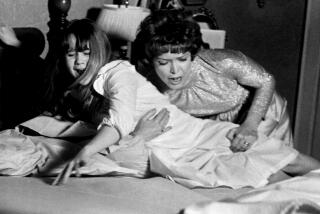The Church Must Exorcise the Demon of Celibacy
- Share via
As the number of accusations of sexual abuse of minors by priests has grown, officials of the Roman Catholic Church have been forced, under the glare of public scrutiny, to confront the problems plaguing the priesthood. Unfortunately, they’re unlikely to get to one of the principal roots of the problem: the church’s mandatory requirement of celibacy.
For priests who love their ministry but do not feel called to live a celibate life, the celibacy discipline is a continual torment, requiring them to sacrifice their desires for intimacy, marriage and fatherhood. Repression of these powerful human instincts over a lifetime can easily lead to profound loneliness and can foster a disposition toward sexual deviancy.
Nearly every study conducted over the past 35 years has shown that the primary motive for the departure of more than 100,000 Catholic priests is that they wanted to marry. The No.1 reason why young men do not enter the seminary is that they are not allowed to marry. One consequence of this celibacy requirement is ominous for the future of the priesthood: Seminary enrollment in the U.S. has plummeted from 48,000 in 1965 to less than 4,000 today.
The celibacy discipline is even more tenuous when considered historically. St. Peter, the first pope, was married, as were at least 39 others documented during the church’s first 12 centuries. Many of the clergy had wives. The Eastern Rite of the Catholic Church has experienced an unbroken tradition of married and celibate clergy for almost 2,000 years. Why was celibacy imposed on priests in the Roman Rite?
Responding to the moral excesses of the collapsing Roman Empire, some popes believed that all sexual intimacy, even conjugal love, was impure. Furthermore, the papacy wanted to control the appointments of bishops and the disbursement of church benefices. Starting in the 4th century, it attempted to address these concerns by ordering all married bishops and priests to abstain from sex with their wives. No conjugal intercourse, no children. Married bishops would have no sons to entrust with their ministry and property. The papacy would then gain control of the appointments of bishops and benefices.
Married clergy resisted, but increasingly restrictive laws, fines, imprisonment, public beatings and dismissals carried the day. At the second Lateran Council in 1139, the papacy enacted laws that nullified the marriages of priests, prohibited unmarried priests to marry and required aspirants to the priesthood to promise never to marry.
The imposition of this discipline defied human nature, degraded marriage and contradicted Jesus’ teaching that marriage is an inviolable blessing. It created a profound moral and institutional disorder.
The fallout continues to this day. Priests who want to marry must leave the priesthood. Mature men are barred from entering it for the sole reason that they are married. The all-male seminary environment makes it extremely difficult for teenage candidates for the priesthood to achieve sexual maturity. These factors drastically reduce both the number and quality of priests.
While there have been many celibates whose lives have been inspirations, the history of celibacy is littered with priests, bishops, cardinals and popes who have responded to the canonically mandated suppression of their natural instincts with sexual excess and perversion. Today’s scandals are part of an unbroken chain of abuses dating back to when celibacy laws were first imposed. The papacy should have listened to St. Paul’s warning: “Those who say marriage is forbidden are uttering the doctrine of demons.”
Celibacy does not cause pedophilia, any more than marriage causes pedophilia. Pedophilia is not caused by sexual abstinence, nor is it caused by conjugal love. Pedophiles are psychologically locked into associating sexual power and ecstasy with pre-puberty minors.
Effective management of the church’s sexual-abuse scandal will require apologies, restitution to the victims and punishment for the perpetrators and for those who protected or facilitated the abuse. But more is needed.
A worldwide council should be convened and, to be credible, must include, with a voting voice, laity as well as clergy. Its goal should be the restoration of the church’s credibility and the sexual integrity of the priesthood. Sexual-abuse victims and their families should have a pre-eminent voice in defining the healing they need and the guidelines that will prevent a recurrence of their tragedies. Finally, priests should be allowed to choose whether celibacy or marriage is the best way for them to serve the church.
This reform will not eliminate all pedophile priests, nor all clergy sexual abuse. But a married priesthood will make it harder for abuses to take root. More important, it will show, once again, that conjugal love and priestly ministry profoundly enrich the church, rather than undermine it.
More to Read
Sign up for Essential California
The most important California stories and recommendations in your inbox every morning.
You may occasionally receive promotional content from the Los Angeles Times.










